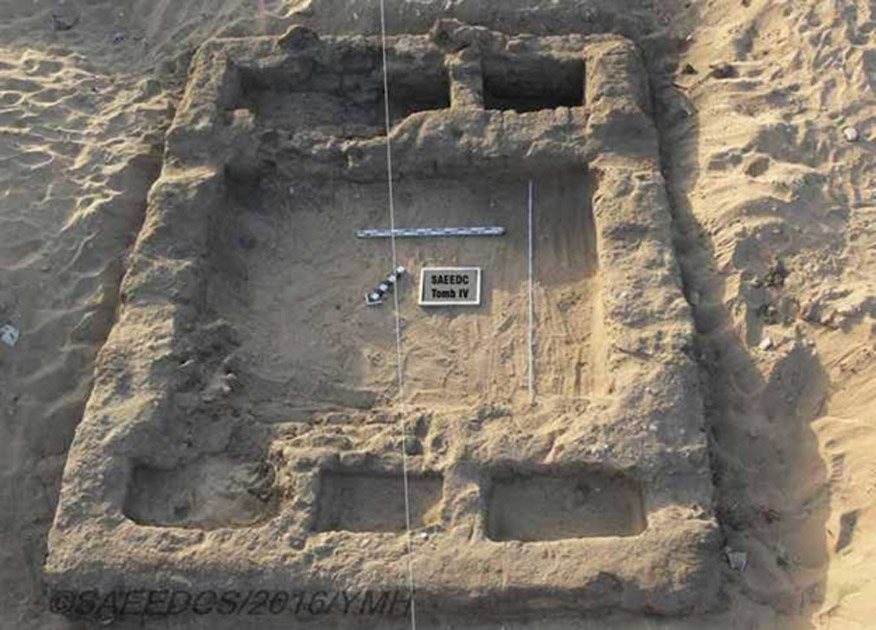
Archaeologists working in Egypt have made an unprecedented find of a previously unknown city containing huts, iron and stone tools, pottery, and even a small cemetery in the southern province of Sohag.
This Day in History: The Barbie Doll Makes Its DebutKeep Watching
The Guardian reports that the archaeologists unearthed their fantastic find just 400 meters (1312.34 ft.) from the Temple of Seti I, across the Nile from Luxor. It is believed that the forgotten city once housed high-ranking officials and grave builders and dates to about 5316 BC.

“A section of the newly-discovered site with some artifacts found within it.”
So far, the archaeologists have found 15 large mastabas (mudbrick tombs). However, this may be a question of quality over quantity, as Antiquities Minister Mahmoud Afifi said in a statement :
“The size of the graves discovered in the cemetery is larger in some instances than royal graves in Abydos dating back to the first dynasty, which proves the importance of the people buried there and their high social standing during this early era of ancient Egyptian history.”
The Abydos King List is a trove of information, preserving the identities of 76 kings of ancient Egypt
The stunning temple of Seti I in Abydos, Egypt

“One of the excavated graves.”
Egypt Independent says the excavations are underway by an Egyptian archaeological mission belonging to the Ministry of Antiquities. The group consists of “young Egyptian archaeologists specialized in excavations, pottery, paintings and human bones.”
The antiquities ministry hopes that the discovery will provide new information on Abydos, one of ancient Egypt’s oldest (3,100 – 332 BC) and most important archaeological sites.
The Abydos boats are some of the fascinating artifacts that have been found there during previous excavations. The large size and features of the boats suggest that they could have been used for sailing, however the funerary links tend to dominate over that idea.
Abydos carvings
The Abydos Boats: Transporting the Pharaohs Through the Afterlife

“Some of the Abydos boats in their brick-built graves.”
Yet, one of the most memorable features of Abydos is the temple of Seti I. The iconic structure was built mainly of limestone, though some sections were made with sandstone. Ancient Origins writer Dwhty provides more information on the temple’s characteristics:
“Seti’s temple was dedicated to Osiris, and consisted of a pylon, two open courts, two hypostyle halls, seven shrines, each to an important Egyptian deity (Horus, Isis, Osiris, Amun-Ra, Ra-Horakhty and Ptah) and one to Seti himself, a chapel dedicated to the different forms of the god Osiris, and several chambers to the south. In addition to the main temple, there was also an Osireion at the back of it. Various additions to the temple were made by later pharaohs, including those from the Late, Ptolemaic and Roman periods.”

“Entrance to the Temple of Seti I.”
This temple in Abydos is among the most famous in the country and some scholars claim it is the “most impressive religious structure still standing in Egypt.” Even though Seti I began the work on the temple, it was not completed until his son, Ramesses II , reigned. Despite Seti bringing order back to Egypt following the disruption caused by Akhenaten’s religious reforms , his story is largely overshadowed by his more famous son.
Regarding the pharaoh and his kin, within Seti I’s temple, one can find the well-known Abydos King List . This is a list of 76 Egyptian kings which has proven itself a useful tool in deciphering ancient Egyptian history – even if it is not complete.

“Drawing of cartouches on the Abydos King List.”
But there may be even more intriguing information tucked away in the Temple of Seti I. John Black described one of the more controversial finds made within Seti’s temple for Ancient Origins. He wrote:
“On one of the ceilings of the temple, strange hieroglyphs were found that sparked a debate between Egyptologists. The carvings appear to depict modern vehicles resembling a helicopter, a submarine, and airplanes. At first the images circulating were thought to be fakes, but were later filmed and verified as valid images. Yet, even if these images clearly appear to resemble twentieth century machines, Egyptologists have tried to offer a rational explanation.”

“Hieroglyphs showing seemingly modern aircraft and vehicles in the Temple of Seti I in Abydos.”
Though debate continues about that provocative subject, the most recent find hints that there are still many secrets waiting to be exposed around the ancient Egyptian site of Abydos.
source:ancient-origins.net








